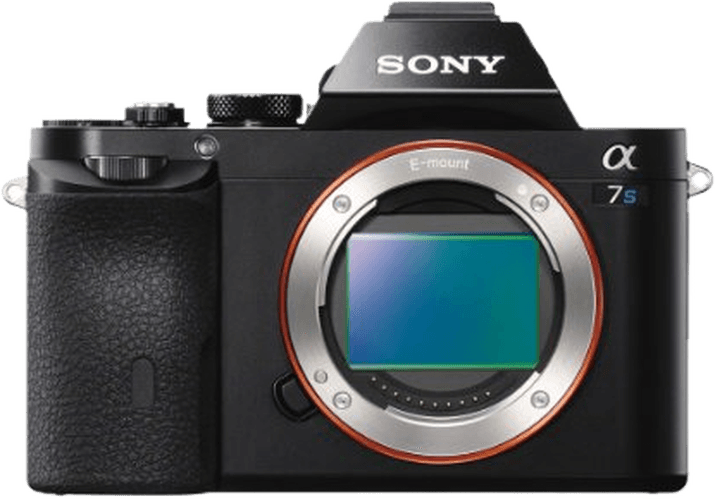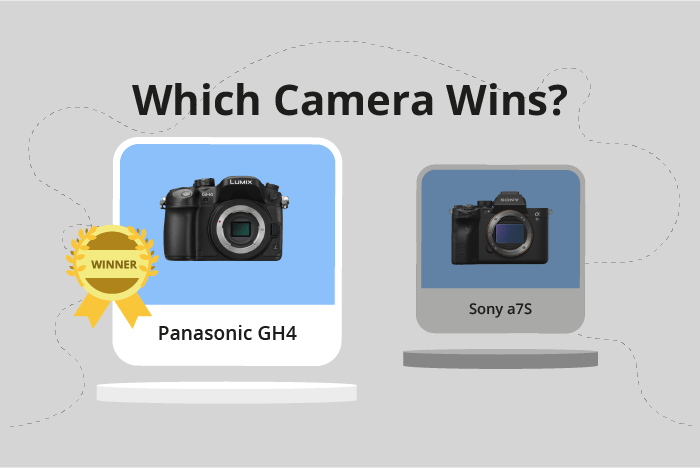Panasonic Lumix DMC-GH4 vs Sony a7S Comparison
Panasonic Lumix DMC-GH4

Sony a7S

The Panasonic Lumix DMC-GH4 edges out the Sony a7S with a score of 58/100 compared to 55/100. Both cameras are mirrorless and were released in 2014, with the GH4 launching at $1700 and the a7S at $2499. They share similar dimensions, but the GH4 is slightly larger at 133 x 93 x 84mm and heavier at 560g, while the a7S is 127 x 94 x 48mm and weighs 489g.
The GH4’s higher score reflects its advantages, such as a lower launch price and better overall performance. However, the a7S has its merits as well, with a more compact design and lighter weight, making it easier to carry around.
Considering the specifications, the Panasonic Lumix DMC-GH4 is the better choice for those seeking a balance of quality and affordability, while the Sony a7S may appeal to users who prioritize compactness and portability.
Panasonic Lumix DMC-GH4 vs Sony a7S Overview and Optics
The Sony a7S outperforms the Panasonic Lumix DMC-GH4 in optics, scoring 60 out of 100 compared to the GH4’s 52. Both cameras share certain specifications, such as the CMOS sensor type, lack of image stabilization, and similar processors – the Bionz X for the Sony a7S and Venus Engine IX for the GH4. However, there are distinct differences that give each camera its unique advantages.
The Sony a7S has a higher DXOMARK sensor score of 87, compared to the GH4’s score of 74. This results in better image quality and low-light performance. Additionally, the a7S features a full-frame sensor and Sony FE lens mount, offering compatibility with a wide range of high-quality lenses. The larger sensor size and 3:2 aspect ratio also contribute to its superior image quality.
On the other hand, the Panasonic GH4 has more megapixels (16) and a faster shooting speed (12) compared to the a7S’s 12.2 megapixels and 5 shooting speed. This allows for capturing more detail in images and faster continuous shooting. The GH4 also uses the Micro Four Thirds sensor size and Micro 4/3 lens mount, providing access to a variety of lenses, albeit not as extensive as the Sony FE mount.
While the Sony a7S triumphs in image quality and lens compatibility, the Panasonic GH4 excels in capturing detail and faster shooting. Therefore, the a7S is the better choice for photographers prioritizing image quality and low-light performance, while the GH4 is suited for those seeking higher resolution and faster shooting capabilities.
Panasonic Lumix DMC-GH4 vs Sony a7S Video Performance
The Panasonic Lumix DMC-GH4 emerges as the winner in the video capabilities comparison with a score of 70/100, while the Sony a7S lags behind with a score of 56/100. Both cameras share some common features, such as offering high-definition video recording and manual exposure control.
The Panasonic Lumix DMC-GH4 outperforms the Sony a7S in several aspects. Firstly, it boasts a maximum video resolution of 4K (4096 x 2160) compared to the Sony a7S’s Full HD (1920 x 1080) resolution. This means that the GH4 can capture more details and produce sharper video footage. Furthermore, the GH4 has a built-in time-lapse functionality, allowing users to create time-lapse videos without the need for additional software or equipment.
On the other hand, the Sony a7S has a higher maximum video frame rate of 60fps, compared to the GH4’s 24fps. This allows the a7S to produce smoother video footage, especially in fast-paced scenes or when recording sports events. However, this advantage may not be significant for users who prioritize video resolution over frame rates.
In terms of video capabilities, the Panasonic Lumix DMC-GH4 is the clear winner due to its superior video resolution and built-in time-lapse feature. The Sony a7S, while offering a higher frame rate, falls short in comparison with its lower video resolution and lack of time-lapse functionality. Users looking for the best video performance should opt for the Panasonic Lumix DMC-GH4, while those who prioritize smooth video footage may still find value in the Sony a7S.
Panasonic Lumix DMC-GH4 vs Sony a7S Features and Benefits
The Panasonic Lumix DMC-GH4 outperforms the Sony a7S with a feature score of 70/100, compared to the Sony a7S’s score of 54/100. Both cameras share some common specifications, such as a 3-inch screen size, flip screens, no GPS, WIFI connectivity, and no Bluetooth.
The GH4 has a higher screen resolution at 1,036,000 dots, while the a7S has a resolution of 921,000 dots. This difference in resolution allows the GH4 to deliver clearer and sharper images on the screen. Additionally, the GH4 has a touchscreen, which the a7S lacks. The touchscreen allows for easier navigation and quicker access to settings, enhancing the overall user experience.
Despite the lower feature score, the Sony a7S still has advantages over the GH4. Both cameras have flip screens, which are useful for shooting at various angles and for vlogging. The a7S and GH4 also share WIFI capabilities, allowing for easy image transfer and remote control.
The Panasonic Lumix DMC-GH4’s higher feature score reflects its better performance in terms of screen resolution and the added touchscreen functionality. However, the Sony a7S remains a strong contender with shared features such as flip screens and WIFI connectivity. The choice between these two cameras will ultimately depend on the individual’s specific needs and preferences. The GH4 is better for those who prioritize screen resolution and touchscreens, while the a7S may be more suitable for users who do not require these additional features.
Panasonic Lumix DMC-GH4 vs Sony a7S Storage and Battery
The Panasonic Lumix DMC-GH4 outperforms the Sony a7S in storage and battery, scoring 60/100 compared to the Sony’s 21/100. Both cameras accept SD, SDHC, and SDXC memory cards, but the GH4 has two memory card slots while the a7S only has one. Additionally, the a7S accepts Memory Stick Duo, Pro Duo, and Pro-HG Duo cards.
The GH4’s battery life lasts for 500 shots, while the a7S can only manage 380 shots. Both cameras use different battery types, with the GH4 using a DMW-BLF19 battery and the a7S using an NP-FW50 battery. Neither camera offers USB charging capabilities.
The GH4’s longer battery life and additional memory card slot make it the superior choice for storage and battery performance. However, the a7S does provide compatibility with Memory Stick cards, which may be a bonus for some users. Ultimately, the Panasonic Lumix DMC-GH4 is the clear winner in this category, providing greater flexibility and longevity for photographers.
Alternatives to the Panasonic Lumix DMC-GH4 and Sony a7S
Are you still undecided about which camera is right for you? Have a look at these popular comparisons that feature the Panasonic Lumix DMC-GH4 or the Sony a7S:

